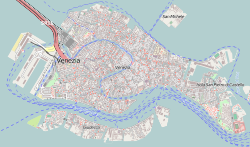| San Lorenzo | |
|---|---|
 San Lorenzo di Venezia | |
| Religion | |
| Affiliation | Roman Catholic |
| Province | Venice |
| Location | |
| Location | Venice, Italy |
| Coordinates | 45°26′14″N12°20′44″E / 45.43722°N 12.34556°E |
| Architecture | |
| Completed | 9th century |
San Lorenzo is a church building in the sestiere of Castello of Venice, northern Italy.
The church dates to the 9th century, and became attached to the neighboring Benedictine monastery. It was rebuilt in 1580–1616 to designs by Simone Sorela. The high altar was partially sculpted by Giovanni Maria da Cannaregio using designs by Girolamo Campagna. The latter sculptor completed the statues of Saints Lawrence and Sebastian. Marco Polo was buried there, per his request on his deathbed. His remains had been in the chapel of St. Sebastian, [1] which was demolished in 1580. [2] Since then there has been no information regarding the whereabouts of his remains, which are consequently missing.
Saint Paul I of Constantinople relics were brought to Venice in 1226. They are currently kept in San Lorenzo.


